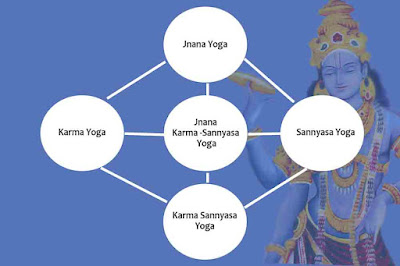Jnana Karma Sannyasa Yogam | Introduction
Srimad Bhagavad Gita
Chapter 4

Jnana Karma Sannyasa Yogam
Introduction
🌸🌸🌸🌸🌸🌸🌸
Jnana Karma Sannyasa Yogam is the title for the fourth chapter of Shrimad Bhagavad Gita as the effective path leading to self-realization. As the name indicates, sadhakas performing the jnana karma sannyasa yogam, combine the best characteristics of jnana (knowledge), karma (action) and sannyasa (renunciation) to neutralize the ill effects of attachment attributes arising from the actions (karma bandha) thereby attain the divine union (yogam) with the higher ideal. Jnana Karma Sannyasa Yogam denotes the enlightened state (the yogam) of a karma yogi wherein the sadhaka remains in the effect of tranquility by using the combination of Jnana, Karma, and Yajna or Sannyasa principles.
Jnana
Karma Sannyasa Yogam is fundamentally the performance of karma yoga with correct
mindfulness, accurate thoughtfulness, precise discrimination, and true
attitude. In this exercise, our karmas are purified by the knowledge effect on
one side and by renunciation on the other side. In this way, the karmas, and
the karma phala, do not happen as an attachment to the sadhaka, thereby
completely avoiding any karmic reactions or sinfulness.
Jnana
Karma Sannyasa Yogam is best suited for the normal household people who lead
worldly lives. When the path of knowledge (jnana yoga), the path of actions
(karma yoga) and the path of renunciation (sannyasa yoga) are combined and
performed, it gives more virtue to the mankind than when they are practiced in
isolation since it harmoniously integrates the triple principles as envisaged
in the Vedas.
In
chapter 4, Bhagavan opens the narration with a dramatic introduction of His
divine attribute and quickly flashes the symbols of the incarnation characteristics.
Then Sri Krishna narrates the all impotant shloka of “yadā yadā hi dharmasya
glānir bhavati bhārata |abhyutthānam adharmasya tadātmānaṁ sṛijāmyaham
|paritrāṇāya sādhūnāṁ
vināśhāya cha duṣhkṛitām |dharma-sansthāpanārthāya sambhavāmi yuge
yuge |Whenever there is a decline in righteousness, and a rise in sinfulness
prevails, then do I manifest myself, O Bhaarata. In order to protect the
virtuous, to rout the sinful, and to re-establish the values of dharma I
manifest, age after age.
Sri
Krishna then moves on to the formation of chatur varnas system, correct
understanding of the virtuous karmas & sinful karmas, immaculate
description of various forms of yajnas, introduction to dhyana & pranayama,
and then Bhagavan enters to the explanation of the benefits of jnana yogam with
important emphasis on the role of the Guru.
Shlokam
24 is a very popular one in this chapter: “brahmārpaṇaṁ
brahma havir brahmāgnau brahmaṇā hutam |brahmaiva
tena gantavyaṁ brahma-karma-samādhinā |” For the one who is
entirely engrossed in divine realization, the offering or oblation is Brahman,
the ladle, or the scoop with which the yajna is performed is Brahman, the act
of offering the yajna is Brahman, and the sacrificial fire the yaga-agni is
also Brahman. Such a person, who perceives the whole scenario as higher ideal or
the eternal essence, easily attain the Brahman.
Let
us step into the path of Chapter 4, Jnana Karma Sannyasa Yogam by learning the
messages by each Shlokam and thereby attain the nectar wisdom offered by Bhagavan
Sri Krishna and Maharshi Veda Vyasa.
🌺🌺🌺🌺🌺🌺🌺
Ref: www.hinduwebsite.com, Bhavartha Bodhini



Comments
Post a Comment